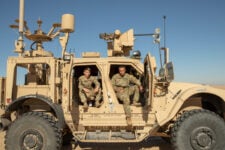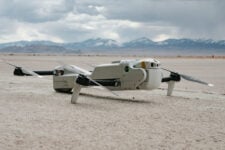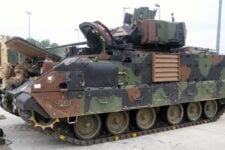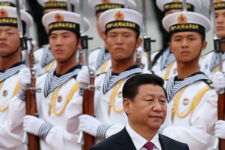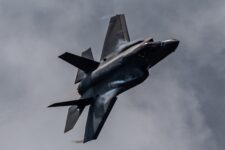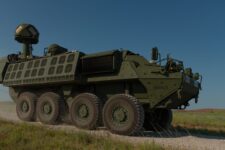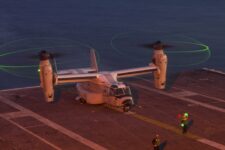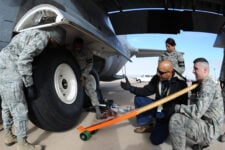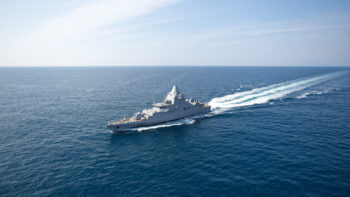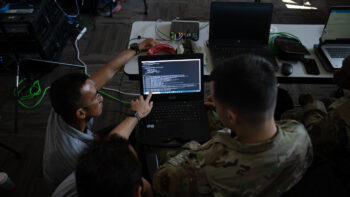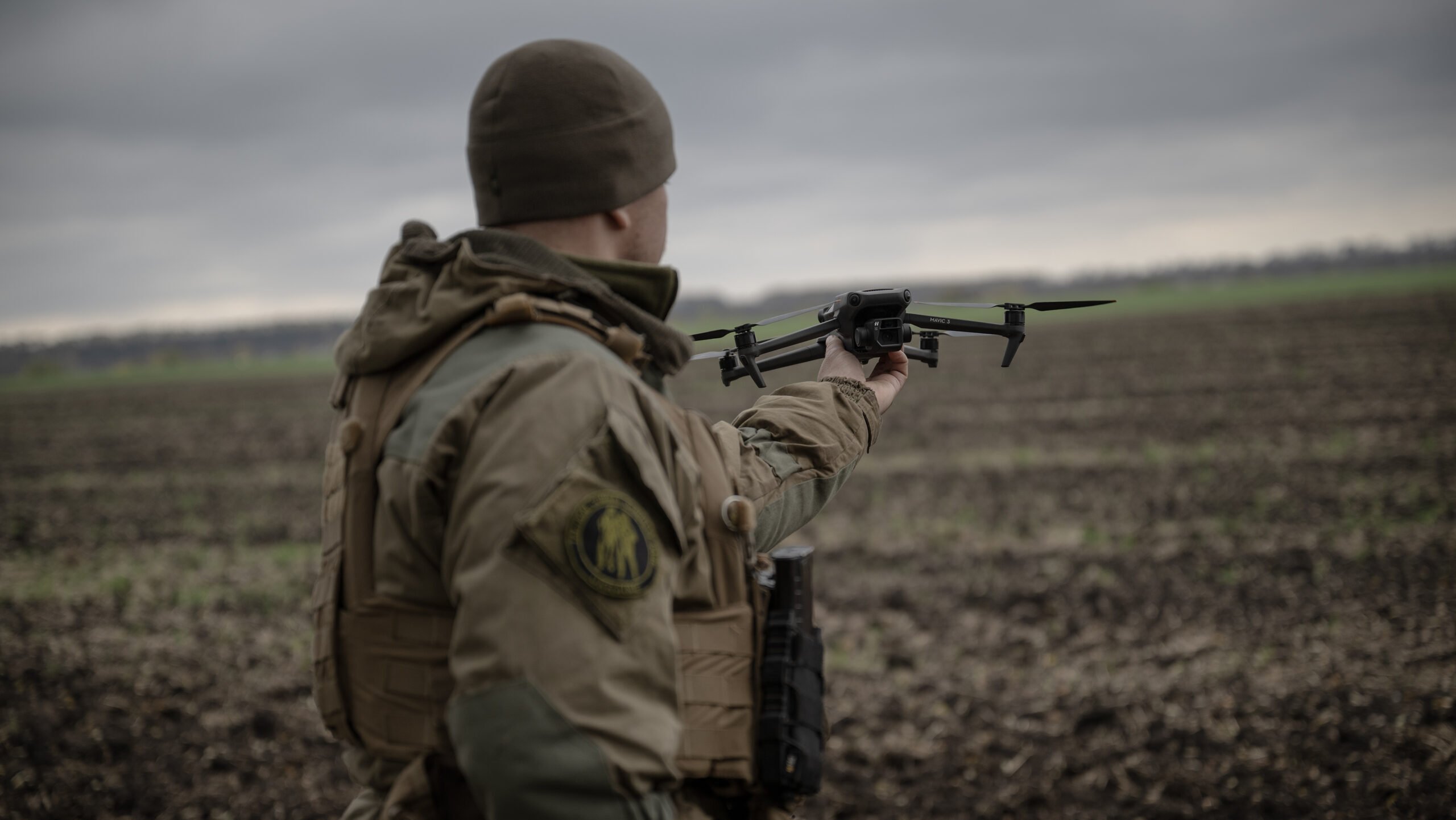
The drone unit of the 108th Territorial Defense Brigade of the Ukrainian Army continues its combat training as heavy clashes continue on the Zaporizhzhia frontline in Ukraine (Photo: Getty Images)
BELFAST — “I know serious delays in support have meant serious consequences on the battlefield,” said Jens Stoltenberg, NATO Secretary General, as he made a surprise visit to Kyiv on April 29.
Calling out US political paralysis and European failures at “scale,” the NATO chief spoke in surprisingly candid terms about how Ukraine had been let down by its friends in recent months, leading to advances by invading Russian forces. Stoltenberg didn’t go as far as to personally apologize to Ukraine President Volodymyr Zelenskyy, standing beside him, for the frontline problems, but the moment was telling from the usually even-keeled NATO chief.
The good news for Ukraine supporters, however, is that while the alliance has been slow to deliver weapons in the last year, there is now a multi-pronged, if occasionally confusing effort underway to create a long-lasting pipeline for Kyiv’s aid.
While US funding problems have been resolved after the Senate passed a $95 billion foreign aid bill last month, the Ukraine Defense Contact Group, a collection of 50 nations offering military assistance to the eastern European country, has been working to ease supply issues through a collection of eight capability coalitions, established in February. As of April 26, the Contact Group had collectively committed a total of $95 billion in “security assistance” to Ukraine, according to US Defense Secretary Lloyd Austin.
The capability coalitions all work off Ukraine equipment requirements. Typically led by two to three nations at a time, the coalitions each offer Ukraine additional supplies of highly capable equipment including fighter jets, drones, air defense systems, artillery, ammunition, tanks, naval vessels and remote detonation systems for demining.
But while Kyiv works to incorporate assets from so many places into its battle plans, it can be equally difficult for observers to know who’s in charge of what, where. So, below is a guide to the coalitions themselves, a look at why they have been developed, what experts think of the plan and how the efforts have progressed to date.
Jump to a specific coalition:
- Air Force: Denmark, Netherlands, US
- Armor: Germany, Poland
- Artillery: France, US
- Demining: Iceland, Lithuania
- Drones: Latvia, UK
- Integrated Air and Missile Defense: France, Germany
- Information Technology: Estonia, Luxembourg
- Maritime Security: Norway, UK
Air Force: Denmark, The Netherlands, US
Aim: To train Ukraine pilots, maintainers and support crew on F-16 fourth-generation fighter jets and to supply fighter jets themselves to Kyiv. The Western jets will offer a significant boost to Ukraine’s estimated pre-war inventory of 120 “combat capable” aircraft, mainly Soviet era Mig-29s and Su-27s, according to the BBC.
“We are aiming to provide an initial operating capability for Ukraine with its F-16 program in 2024, which would entail trained pilots, the platforms, but in addition, trained maintainers and sustainers, infrastructure, and spare parts, ammunition,” Celeste Wallander, US Assistant Secretary for International Security Affairs, told reporters in January.
Asked for an update on pilot training during a small reporter roundtable on April 25, Jake Sullivan, the US National Security Advisor, said “It’s moving. I can’t give you a date for when we’ll see the first deployments to Ukraine.”
Expert view: Analysis suggests that once operational, Ukraine will use the second-hand jets to intercept Russian cruise and other surface-to-air missiles or potentially deploy them as air support for ground operations. Future strikes employing AGM-88 HARM (high-speed anti-radiation missile) weapons against Russian surface-to-air missile (SAM) systems could also be vital to Ukraine developing “local air superiority” and increasing survivability of its drone arsenal, RAND noted last year.
Similarly, the Congressional Research Service suggested in a March 2023 report that those in favor of transferring US or NATO fighter jets to Ukraine backed the idea because it could help to close “perceived gaps in operational capabilities,” like “air superiority; suppression of enemy air defenses; intelligence, surveillance, and reconnaissance; and counter-land (air-to-ground) capabilities.”
On the other hand, there are a number of concerns around how effective the F-16s can be and whether they will ultimately deliver a decisive blow for Ukraine.
“Western fighters will undoubtedly provide a major boost to Ukrainian Air Force survivability and air-to-air lethality against the Russian VKS once supplied,” Justin Bronk, senior research fellow for airpower and technology at RUSI on X (formerly Twitter) a year ago. “However, they would still be at risk from Russia’s SAM systems, and have limited dynamic ground attack options.”
Analysis from the Quincy Institute for Responsible Statecraft, a foreign policy think tank, suggests that long training periods for pilots to become “proficient” in air-to-air combat, a lack of stealth characteristics that make the jets “vulnerable” to attack by Russian S-300 and S-400 SAMs, and the fact they won’t be operating alongside supporting AWACS planes like the Boeing E-3 Sentry could all limit the jets’ usefulness at the front.
Other named partners: A total of 16 countries are involved in the fighter program. Belgium, Denmark, Norway and the Netherlands have all committed to supply aircraft to Ukraine. Denmark, Romania, the UK and the US host pilot training. So far, the US has declined to supply its own F-16s, which are produced in America.
The Netherlands Ministry of Defence is readying 6 additional F-16 fighter aircraft for delivery to Ukraine. This brings the total number to 24 F-16s. 🇺🇦's aerial superiority is essential for countering Russian aggression.#StandWithUkraine
— Kajsa Ollongren (@DefensieMin) February 5, 2024
Host training centers: Morris Air National Guard Base, Arizona; The 86th “Lieutenant Aviator Gheorghe Mociorniță” Air Base in Borcea, near Fetesti, Romania; Skrydstrup Air Base, southern Denmark; undisclosed UK location for basic training.
Status: European countries have so far pledged 45 jets for delivery to Ukraine, with a first, from Denmark, to be handed over in the summer. Additionally, the Netherlands has so far delivered 11 planes to the European F-16 training center in Romania.
“The Danish Armed Forces have no comments on numbers or timetables for the training of Ukrainian pilots, other than that the training is expected to be completed in relation to the donation of F-16 fighter jets during the summer of 2024,” a spokesperson for Denmark’s Defence Command told Breaking Defense in a statement.
Ukrainian pilots from the Morris Air National Guard base in Arizona are expected to graduate “no later than this fall, assuming everything moves along as expected,” a US Department of Defense spokesperson told Breaking Defense. A total of 12 pilots are set to be trained by the US in fiscal 2024, said Capt. Erin Hannigan, Arizona National Guard spokesperson, according to Defense One.
A group of 10 Ukrainian pilots also completed elementary flying training in the UK with the Royal Air Force last month, covering general handling, instrument flying, low-level navigation and advanced formation flying. The cohort were trained using Grob Tutor aircraft at an undisclosed location in preparation for advanced jet training and conversion on F-16 jets with air force coalition partners. The UK has provided basic and English-language training to Ukrainian pilots since August 2023.
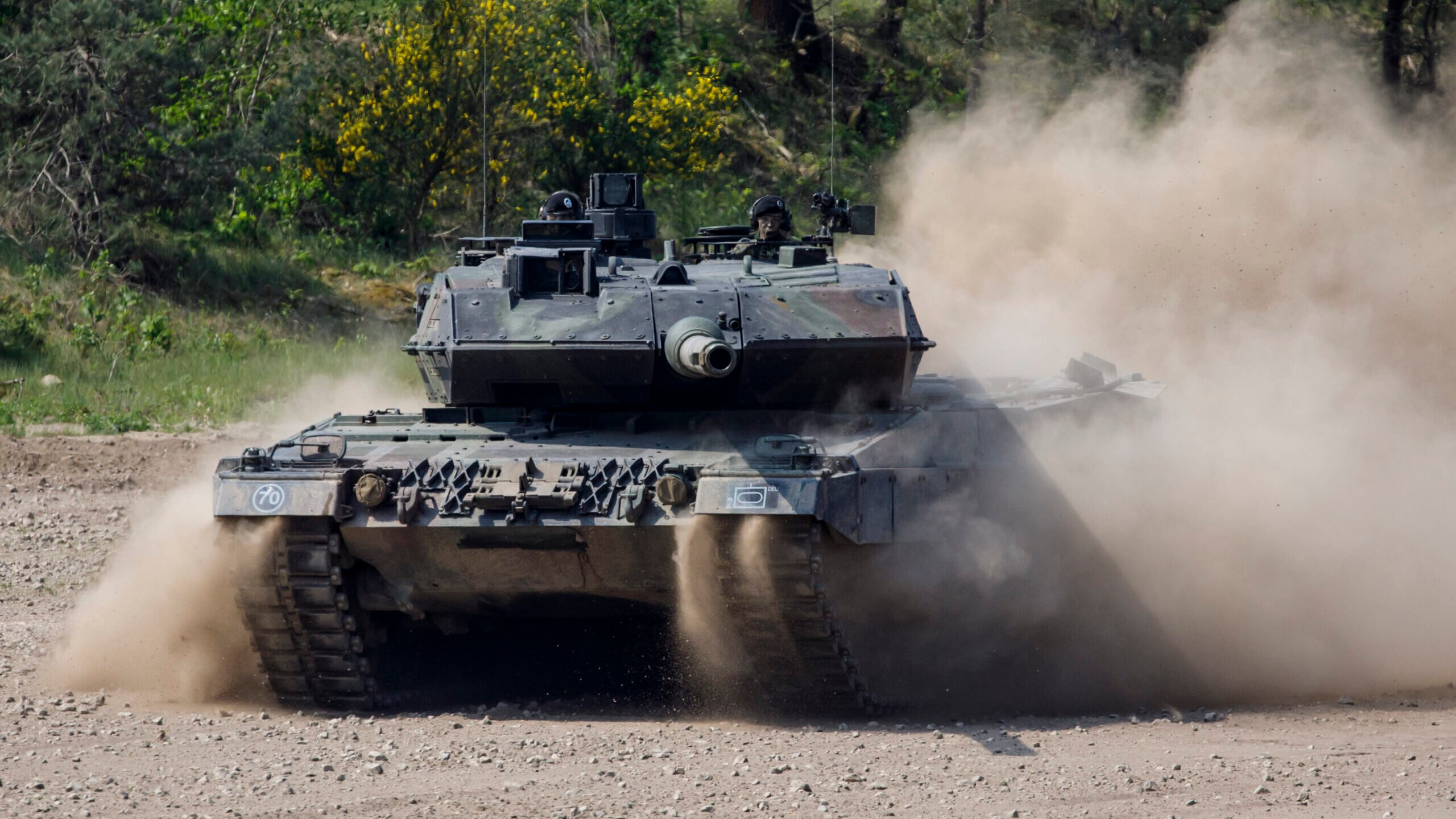
A Leopard Tank of the Bundeswehr Panzerlehrbrigade 9 (9th Armoured Demonstration Brigade) during a presentation of capabilities by the unit on May 20, 2019 in Munster, Germany. (Morris MacMatzen/Getty Images)
Armor: Germany, Poland
Aim: To supply main battle tanks to Kyiv. Few details of the armor coalition have emerged since Germany and Poland formally agreed to activate their armor partnership in March, but the move consolidates firm cooperation between the two countries relating to supplies of Leopard 2 main battle tanks. As part of a joint effort, launched in February 2023, Berlin agreed to deliver Leopard 2A6 vehicles, with Poland committing to provide 2A4 platforms.
Expert view: The Leopard 2 has been lauded by the International Institute for Strategic Studies as “arguably the most successful modern Western MBT design,” with the think tank suggesting that even the most dated configuration, 2A4, offers Ukraine more advanced capabilities than its Soviet-era inventory, mainly courtesy of “more modern optics and fire-control systems.”
Other named partners: Italy, Sweden and the UK have applied to join the coalition.
Status: Officials have not shared how the armor coalition has progressed. At a more general level, Leopard 2 tanks have suffered a relatively low loss rate during the conflict with Russia, suggesting it is highly survivable and as capable as forecast by analysts. Since German deliveries to Ukraine started in March 2023, Russia has destroyed a total of 15 vehicles, according to the open source intelligence blog Oryx, which charts equipment losses from the war, based on visual evidence. In February 2024, IISS estimated that Russia had lost 3,000 tanks since the conflict started.
The US is separately supplying its Abrams tanks to Ukraine, but recent news reports suggest it hasn’t fared quite as well: Ukraine has started to pull them back from the front lines as they’ve proven too easy to spot by drones.
Artillery: France, US
Aim: To boost Ukraine’s immediate ammunition needs and supply 78 Caesar 155mm Howitzers, partly financed by other nations. Ukraine ordered six units prior to launch of the artillery coalition. France has committed €50 million ($53 million) to buy 12 of the other 72 howitzers and wants the remaining 60 to be funded by other allies or the European Defence Agency.
French Army Maj. Gen. Jean-Michel Guillotin, head of the artillery coalition, said in a January 25 press conference that two short-term objectives were being prioritized: redressing a six-to-one ammo firing ratio, heavily favoring Russia, and bolstering repair and maintenance capabilities to fix unusable equipment. At that time he also said that 3,000 155mm shells would be delivered by France to Ukraine every month.
Expert view: Ukraine has long suffered an ammunition shortage owing to US and European manufacturers unable to keep up with demand, and it remains unable to match Russia’s far superior output rate, estimated at 10,000 shells per day.
There also appears little near-term prospect of the West breaking Russia’s ammo production superiority. The Royal United Services Institute (RUSI), a British military think tank, estimates that “Russian overall artillery production is likely to plateau at 3 million rounds per year,” and notes that the Russian MoD is not confident about “significantly” increasing production in the immediate future “unless new factories are set up and raw material extraction is invested in with a lead time beyond five years.”
However, Ukraine is in an even less favorable position. According to a senior European intelligence official, combined efforts of US and European production can generate “1.2 million munitions annually,” reported CNN.
Parity with Russia should be a more realistic prospect once deliveries of an additional 1.5 million rounds, committed from a supporting but separate Czech Republic-led ammo initiative, are made to Ukraine, by a scheduled date of April 2025. That plan involves the Czech government brokering deals for 155mm and 122mm shells with nations from outside Europe, unwilling to sell the ammo to Ukraine directly, but work with an intermediary instead.
Other named partners: 21 nations which include Canada, Germany, Poland and the UK.
Status: France expects delivery of all 78 Caesars to happen by the end of 2024. The French MoD also told Breaking Defense in April that “deliveries of shells are taking place as planned,” suggesting that the coalition goal of 3,000 155mm rounds per month is on track.
After two days in the United States, my work week continues in Brussels.
Right now I am at NATO headquarters, where I met with Danish Prime Minister Mette Frederiksen, Dutch Prime Minister Mark Rutte and Secretary General Jens Stoltenberg.
We talked about how to secure… pic.twitter.com/zJTYTb1Iol
— Petr Fiala (@P_Fiala) April 17, 2024
As for the Czech effort, so far 500,000 of the targeted 1.5 million rounds have been secured, according to Czech Prime Minister Petr Fiala. First deliveries are expected between July and August. As an example of expenditure individual funding partners are putting toward the initiative, Canada’s Department of National Defence said it has committed over CA$53 million ($38.7 million).
Demining: Iceland, Lithuania
Aim: To equip Ukrainian troops, including with remote detonation systems, and train approximately 2,800 Ukrainian troops by the end of the year.
Expert view: As previously reported by Breaking Defense, a senior UK defense official said in January that shorter reconnaissance strike response times, development of a 600-mile front filled with densely packed minefields and anti-tank weapons, and two years worth of warfighting lessons had all contributed to making the Russian Army into a more “proficient” force.
Henrik Faerch, CEO of Danish demining company Damasec Global Group said last year that clearing Ukraine of mines and unexploded ordinance will be the “biggest post-conflict challenge in the history of modern warfare,” and “unlike” any previous conflict.
Analysts stress that Russia has deployed a vast collection of antipersonnel and anti-vehicular mines with networks of minefields uncovered in 11 regions across Ukraine: Chernihivska, Dnipropetrovska, Donetska, Kharkivska, Khersonska, Kyivska, Luhanska, Mykolaivska, Odeska, Sumska and Zaporizka.
Other partner nations: A total of 22 nations are involved, with a “few more” considering joining, Laurynas Kasčiūnas, Lithuania Minister of National Defence, is quoted as saying in a translated April 26 press release.
#Estonia 🇪🇪 joins two more initiatives to #StandWithUkraine 🇺🇦:
🔹The drone coalition led by 🇱🇻 & 🇬🇧
🔹The demining coalition led by 🇱🇹 & 🇮🇸Allies are united to #StopRussianAggression. pic.twitter.com/ZgS1gFeiLA
— MoD Estonia (@MoD_Estonia) February 15, 2024
Status: A third “coordination” meeting of the coalition was held in Vilnius, Lithuania on April 25 to assess “current and future support” from demining supplier countries. Plans for 2025 training and equipment commitments are also underway. Lithuania has so far invested nearly €17 million ($18.1 million) to fund the coalition.
Drones: Latvia, UK
Aim: To supply 1 million drones to Ukraine, including first person view aircraft that have proven highly effective in the fight so far. The goal would match Ukraine’s own aim for massive domestic drone production.
Expert view: “The inability of either side to break through the other’s integrated air defenses has forced them to increase the agility of their fielded forces and rely more heavily on standoff weapons, including long-range artillery, missiles, and drones,” the Council on Foreign Relations said in a January 2024 report. “These conditions have led to the development of new drone technologies that could help Ukraine level the playing field in the air battle and possibly turn the tide of the war in its favor.”
But the Center for New American Security said that as prevalent as drones are, they haven’t offered either side a “decisive edge” to either side — if only because drone-related tactics are evolving so quickly that no advantage lasts for long. “[B]oth parties are engaged in a fast-paced two-sided cycle of innovation and emulation,” a February report from the think tank says. “Because many drone technologies are commercial or dual use, they can be easily acquired, meaning that innovations quickly diffuse to the enemy.”
The strong presence of larger drones like Turkey’s TB2 Medium Altitude Long Endurance (MALE) platform in the early stages of the war in Ukraine has since shifted because of Russia changing its air defense tactics and improved electronic warfare capabilities, analysts told Breaking Defense last year.
At the other end of the scale, though estimated Ukrainian losses of less sophisticated FPW or commercial off-the-shelf quadcopters have been reported at between 5-10,000 a month, analysts have argued that continuing to deploy them in vast numbers is worthwhile because they can undertake riskier missions.
Other partner nations: Australia, Canada, Czech Republic, Denmark, Estonia, Germany, Italy, Lithuania, the Netherlands, Poland and Sweden
🇺🇦Ukraine needs our continuous support to defeat the darkness of Russian aggression. The total support of 🇱🇻Latvia to Ukraine this April will reach 392 million EUR. In 2024 military support to Ukraine will reach 0.25% of our total GDP. It is urgent to help Ukraine with sufficient… pic.twitter.com/bA60TXdtES
— Andris Spruds (@AndrisSpruds) April 4, 2024
Status: On April 17 Latvia said it will “soon send” a first batch of aircraft to Kyiv. Riga has committed to spend €10 million ($10.6 million) annually on drones for Ukraine. The UK says it will supply “thousands” of first person view drones.
Integrated Air and Missile Defense: France, Germany
Aim: To create a NATO-compatible ground-based air defense system for future needs of Ukraine, with working groups broken into three categories: command structure, systems and training/exercise, according to the German Ministry of Defense.
Expert view: Ukraine continues to plead with NATO nations for additional air defense systems, Patriot batteries in particular, as Russian forces sustain attacks on critical infrastructure through a campaign of ballistic, cruise and drone strikes.
Patriot has proven itself over the course of the war, most notably when intercepting Kinzhal hypersonic missiles, but a deadlock at the latest Contact Group for additional supplies of the Raytheon-made weapon could not be broken.
More generally, analysis from IISS suggests that Ukraine’s employment of Soviet era long-range S-300 and medium-range 9K37 Buk Surface to Air Missiles (SAMs) to defeat Russia air threats has been “broadly successful,” but stocks are in danger of being depleted.
Speaking to Breaking Defense last month, Norway’s Chief of Defense, Gen. Eirik Kristoffersen, stated “I have said, and I still say, that air defense is the most crucial [capability] for Ukraine right now.”
Status: A total of 22 nations attended a first meeting of the air defense group held in Berlin last December, a meeting focused on creating a common understanding of “what this [integrated air and missile defense] support can look like and how it can be implemented.” There has been no indication from officials of progress made since then and no timeline for the proposed system to enter service.
“In terms of Patriots, and what they [other nations] might be able to do going forward is left to be seen, but I can tell you that we continue to work on this and in a very earnest manner,” said US Defense Secretary Lloyd Austin on April 26.
Days before, Germany announced it was sending a Patriot battery to Ukraine, the latest in an extensive list of air defense capabilities donated by Berlin, though the government didn’t distinguish between its support and the coalition’s. Likewise, France has sent its own ground-to-air missiles and radars for air defense.
In addition, Spanish defense minister Margarita Robles said that his country had delivered a number of Patriot missiles to Ukraine on Monday, according to the EFE news agency.
In mid-April, Germany wrote to dozens of countries, including Gulf Arab states, asking for air defense systems on Kyiv’s behalf, according to the Financial Times.
“It is important to further bolster our country’s air defense with modern Western-made systems,” said Ukraine President on X in April. “Air defense is our priority today.”
Information Technology: Estonia, Luxembourg
Aim: To support Ukraine’s armed forces to establish a secure and resilient “NATO-standard ICT infrastructure,” designed to deliver increased combat capabilities.
Expert view: Laying out differences in approach to the use of cyber intelligence, a report from the Carnegie Endowment for International Peace think tank claims that Russia values human intelligence gathering “over any other form of intelligence operations,” but Ukraine relies on building its capabilities through “massive assistance” from foreign governments.
“From the time they possessed de facto control of Ukraine, Russian cyber operators seem to have leveraged insider information and threats both to bolster their influence operations and to gain access to Ukrainian IT assets: tapping local agents and collaborators and their intimate knowledge of and access to Ukrainian infrastructure to facilitate cyber operations for intelligence gathering, harassment, subversion, and sabotage,” adds the document.
In related analysis, but written by a different author, the think tank notes that “without discounting the suffering and costs Russian cyber attacks have caused, Ukrainian adaptivity must be part of any analysis about the role of cyber operations in armed conflict,” pointing out that evidence appears to suggest, generally speaking, Russian cyber attacks against Ukraine are not working as well as hoped and certainly not to the extent of Moscow leaning on them as a critical tool, of many, designed to ultimately win the war.
Other named partners: Belgium, the Netherlands, Iceland, Italy, Japan, Lithuania, Latvia, Denmark and the UK
Status: In a brief update, Estonia, a tiny country with an outsized cybersecurity capability, said it shared an “overview” of coalition activities during the most recent Ukraine Defense Contact Group meeting on April 26.
In a May 3 statement, the Ukrainian Ministry of Defense announced “laptops, monitors, and other communication equipment worth 900,000 euros will be distributed to units in the near future” courtesy of the IT coalition.
“The provided equipment will enhance communication and mission planning capabilities at the tactical level. This is one of our priorities — to fulfill requests from units for communication on the front line. We are grateful to our partners for their commitment and speed in decision-making,” said Kateryna Chernohorenko, Deputy Minister of Defense for Digital Transformation, Digital Development, and Digitization, in that same statement.
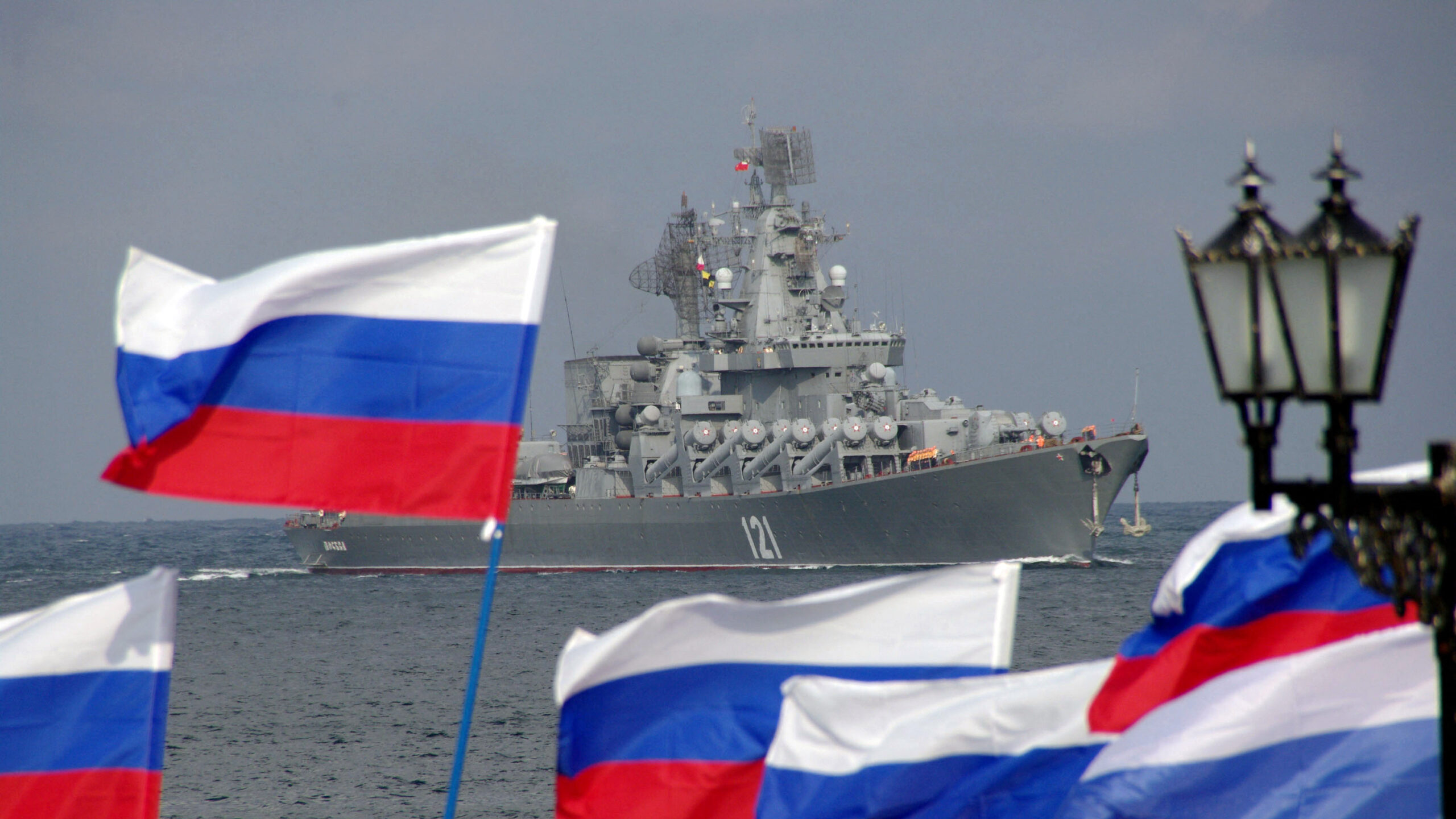
The cruiser Moskva, a flagship of Russian Black Sea Fleet, seen in 2008. Ukraine managed to sink the ship in April 2022, despite Kyiv’s limited naval fleet. (VASILY BATANOV/AFP via Getty Images)
Maritime Security: Norway, UK
Aim: To rapidly develop a Black Sea maritime force and provide Ukraine with two Royal Navy Sandown Class mine countermeasures vessels, Viking armored amphibious vehicles and Marine raiding craft. The coalition is also intended to deliver a long term target of helping “Ukraine transform its navy, making it more compatible with western allies, more interoperable with NATO,” according to the UK. Norway’s contribution involves it assisting in the training of Ukrainian naval personnel.
Expert view: The Atlantic Council argued that before the conflict started, a war at sea between Russia and Ukraine “appeared to be a foregone conclusion” heavily favoring the much more capable Russian Black Sea Fleet.
But in May 2022 Ukraine managed to sink the Moskva, the Russian navy’s flagship vessel, dealing what RAND called “an enormous psychological blow” to Russian forces. In February Ukraine used one-way attack drones to take out the Caesar Kunikov landing ship and the Ivanovets corvette.
“The success achieved over the past year in Crimea and the Black Sea with relatively limited supplies of cruise missiles offers a glimpse of what could be possible if Ukraine’s partners finally agree to deliver long-range missiles in anything like the quantities Kyiv is asking for,” added the Atlantic Council in an updated analysis.
Other named partners: The UK says “other nations [are] contributing” but did not identify them.
Status: The Royal Navy said on April 11 that Sandown Class MCMs are operating with the Ukraine Navy, out of their temporary home of Portsmouth Naval Base, England. The status of deliveries for the other equipment committed to be the UK remains unclear — the British navy did not respond to a request for comment.
Norway donates rubber boats and continues the training of Ukrainian marines in small boat operations this coming year. The support is one part of the long-term commitment to support Ukraine to develop their Maritime Force. pic.twitter.com/UJjkEjPhgD
— Norwegian Armed Forces | Forsvaret (@Forsvaret_no) February 15, 2024
An Uncertain Future
Overall then, the coalitions have so far demonstrated mixed success, but the underlying intention of coordinating supplies in a more efficient way, based on strong financial foundations, should pay off in the long-term — time during which Ukrainian soldiers may be paying with their lives.
Russia is believed to be preparing a major spring offensive. Zelenskyy said his army is preparing as best it can, but it needs allied help if it’s to blunt the attack.
“Timely support for our army. Today I don’t see anything positive on this point yet. There are supplies, they have slightly begun, this process needs to be sped up,” Zelenskyy said April 29.
Christina Mackenzie contributed reporting from Paris, France.


